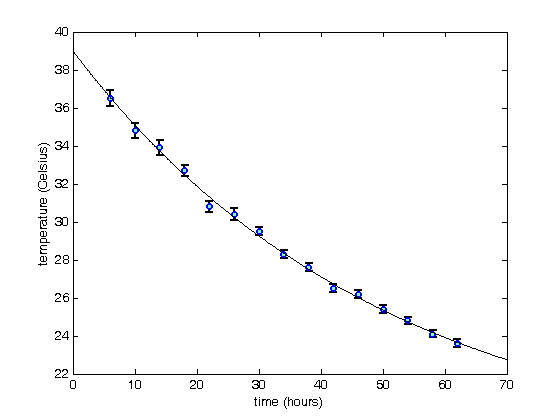% Jake Bobowsk % July 26, 2017 % Created using MATLAB R2014a clearvars format long % In this script we will fit data to a model that is linear in the fit parameters. % The fit will be weighted by the measurement uncertainties. % Enter the data. t = (6:4:62); T = [36.5, 34.8, 33.9, 32.7, 30.8, 30.4, 29.5, 28.3, 27.6, 26.5, 26.2, 25.4, 24.8, 24.1, 23.6]; errT = [0.4, 0.4, 0.4, 0.3, 0.3, 0.3, 0.2, 0.2, 0.2, 0.2, 0.2, 0.2, 0.2, 0.2, 0.2]; % Plot the data using errorbar(x,y,e). errorbar(t, T, errT, 'ko', 'MarkerSize', 5,... 'LineWidth', 1.8,... 'MarkerEdgeColor', 'b',... 'MarkerFaceColor', [.49 1 .63]); xlabel('time (hours)'); ylabel('temperature (Celsius)'); % After completing the fit, we will want to add the best-fit line to our % existing plot. To tell MATLAB to add stuff the the current plot (instead % of creating an entirely new plot), we use 'hold on'. hold on; % The weights are determined using one over the square of the y-errors. % See your PHYS 232 notes for an explanation (or wait until you take the % course). weights = (1./errT).^2; % Here we define the 'fit type' which is the model that we will fit the % data to. The parameters are the symbols that are not x. x is the independent % variable. ft = fittype('Trm*(1 - exp(-x/50)) + T0*exp(-x/50)'); coeffnames(ft) % To do the fit, we will use MATLAB's built-in function "fit". Oddly, fit % requires column vectors for the x, y data and the weights. Use [xdata]' % to convert a row vector of to a column vector. ft specifies that % we're fitting the data to the model defined above. custom_fit = fit([t]', [T]', ft, 'weights', [weights]') % When you execute the script, fit outputs a table showing the best-fit % parameters and their 95% confindence intervals. Below, I show how to % access the best-fit values and the confindence bounds. params = coeffvalues(custom_fit); T0 = params(1) Trm = params(2) % We can estimate an uncertainty in the best-fit parameters by taking % one-half the difference between the upper and lower confidence bounds. % In 'confint' below, I specified 0.68 as the confindence interval, which % corresponds to one sigma. If you leave this option blank, it will % default to a confindence interval of 0.95, or two sigma. ci = confint(custom_fit, 0.68); errT0 = (ci(2, 1) - ci(1, 1))/2 errTrm = (ci(2, 2) - ci(1, 2))/2 % Let's make some data to plot... xx = (0:0.1:70); yfit = Trm*(1 - exp(-xx/50)) + T0*exp(-xx/50); % ...and generate a plot showing the data and the weighted best-fit line. plot(xx, yfit, 'k-'); hold off;
ans =
'T0'
'Trm'
Warning: Start point not provided, choosing random start point.
custom_fit =
General model:
custom_fit(x) = Trm*(1 - exp(-x/50)) + T0*exp(-x/50)
Coefficients (with 95% confidence bounds):
T0 = 39 (38.6, 39.41)
Trm = 17.43 (17.07, 17.78)
T0 =
39.001812669752042
Trm =
17.426777179177751
errT0 =
0.194389140268513
errTrm =
0.170031637028607
